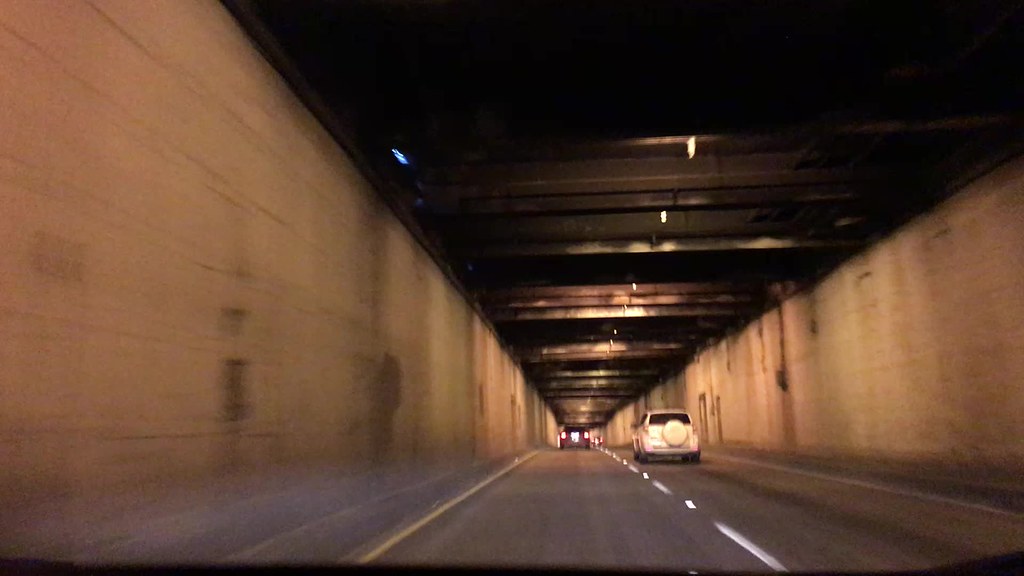
If you’ve not noticed our traffic patterns changing already, you’re going to notice very soon. Starting January 11, 2019, the Puget Sound region will experience the longest closure of a major highway it has ever experienced.
(In addition, there are more than 65 construction cranes dotting our skyline and work is expected to intensify over the coming months.)
The time has come as Seattle prepares to bid its final farewell to the seismically vulnerable and aged SR 99 Alaskan Way Viaduct (the elevated portion of the highway next to the waterfront). On January 11, 2019, the Washington State Department of Transportation (WSDOT) will permanently close the Alaskan Way Viaduct in preparation for opening the new SR 99 tunnel in early February that will offer a direct route for drivers to get through downtown Seattle from the stadiums to the Space Needle.

Alaskan Way Viaduct through downtown Seattle. Circa 1972. Item 169335, Forward Thrust Photographs (Record Series 5804-04), Seattle Municipal Archives.
This means that once the viaduct closes in January, the days of traffic entering the viaduct from downtown’s Columbia Street and exiting the viaduct from Seneca Street will end. Instead, traffic will enter and exit the new tunnel in South Lake Union and SODO. During the three-week closure, both the elevated highway and Battery Street Tunnel (see our Extras section below for a drive through Battery Street Tunnel) will be closed so that WSDOT can realign the highway into the new SR 99 tunnel. See the diagram below, courtesy of WSDOT.
“While we’re excited about the opening of the SR 99 tunnel, it’s important to remember that this is ultimately a safety project, not a congestion-relief project.” – WSDOT
Adjusting to a major closure, new openings, tolls, and another route option.
When the new tunnel opens (it will initially be toll-free), drivers will have to readjust their travel from the closure to the newly opened tunnel route through and under downtown. Then, as soon as the summer of 2019, the tunnel will be tolled. WSDOT predicts that traffic patterns will shift again after the tunnel is tolled – they expect a drop in tunnel traffic as seen from patterns on the tolled SR 520 Bridge and other toll roads in the U.S. Some drivers may use other routes (I-5, Alaskan Way, or local downtown streets) until they realize the value (toll will be within the range of $1-2.25) of time saved by using the much quicker tunnel route. Traffic will make is final adjustments when the new future Alaskan Way surface street improvements are completed in 2021 when drivers will have another option through downtown.
“Much like a weather forecast, these traffic projections aren’t an absolute certainty but they do give us a glimpse into how traffic patterns may change over time. These projections are our best attempts to predict what people may choose to do based on a model of an extremely complex and constantly changing system.” – WSDOT
It’s time to #GetReady.
Traffic will get worse before it gets better. Region-wide traffic disruptions will be unavoidable. We’re working closely with local and regional transit partners, like King County Metro, Sound Transit, the Washington State Department of Transportation (WSDOT) and the Downtown Seattle Association on ways to help you get around downtown as safely and efficiently as possible during this transition. The City has prioritized five downtown mobility strategies to help:
- Transportation system monitoring and managing real-time traffic operations.
- Reducing drive-alone trips downtown.
- Investing in transit to meet demand and expand access.
- Managing construction projects in the public right-of-way.
- Coordinating regional communications. COMING SOON: seattleconnection.org
With these five strategies, here’s how we’re responding to the permanent viaduct closure:
The City of Seattle cannot make mobility changes alone and are commissioning the traveling public to help reduce daily downtown Seattle trips by 1,200 in 2018 and 3,000 in 2019. There is no better time than now to #GetReady.
Stay informed. Follow the SDOT’s and WSDOT’s Twitter channels, blogs, and available online tools.
- SDOT Twitter: @seattledot (for breaking news and updates)
- SDOT Twitter: @SDOTtraffic (for real-time 24/7 traffic news) #periodofmaximumconstraint
- SDOT Blog
- SDOT’s Travelers Map
- WSDOT’s Twitter: @BerthaDigsSR99 #Realign99
- WSDOT’s Blog
- WSDOT’s Traffic Cameras
- WSDOT’s Travel Alerts and Times.
Plan your trip. We’re providing real-time construction and traffic information with popular navigation technologies: Google Maps, Waze, and TomTom. But try transit, ride a bike, form a carpool, or walk.
Figure out a flexible work plan. Help employees plan for a flexible work plan. Contact Commute Seattle who is offering free consultation for businesses. Commute Seattle fosters mobility partnerships and services. Through education, advocacy, training, and consulting, Commute Seattle is helping create a transit-supportive business culture to ensure that commuters enjoy commuter benefits and amenities.
Spread the word. Share this information with your customers, delivery and service providers, and neighbors.
Website coming soon!
Keep a lookout in November 2018 – we’re launching a new website for all your #PeriodofMaximumConstraint information and resources. For detailed information about the Alaskan Way Viaduct closure, new SR 99 tunnel, and SR 99 tolling, visit the WSDOT source.
Extras
Take a drive through the Battery Street Tunnel with us. After January 11, 2019, closure, you will no longer be able to drive through it.



